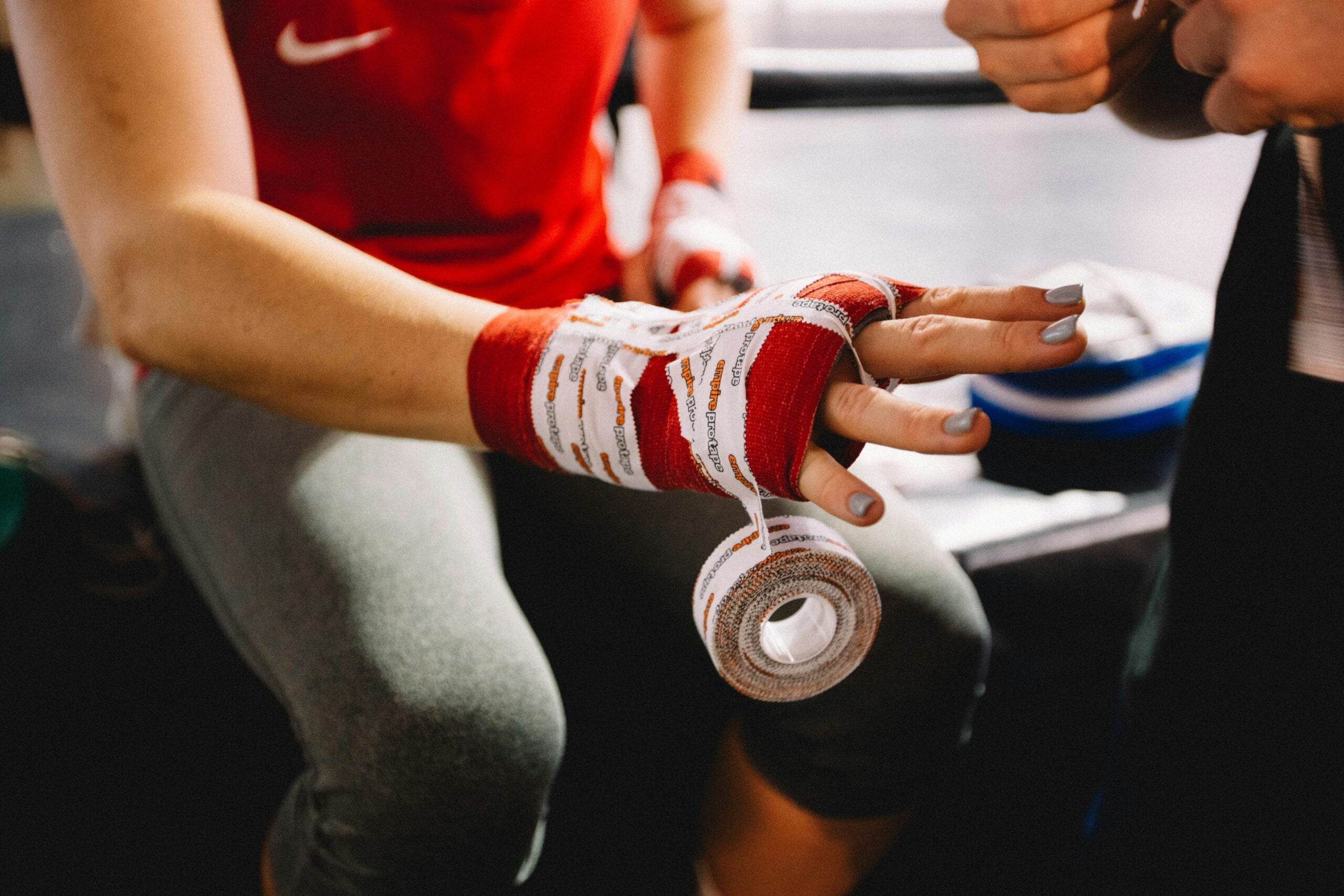martial arts wrapping products
In martial arts, especially disciplines such as Wing Chun that emphasize hand techniques and close-range combat, the practice of wrapping hands and body parts is crucial.
Proper hand and body wrapping serve several key purposes, including injury prevention, improved grip, and enhanced performance.
For martial artists, the integrity of their hands is vital; without proper protection, they risk injuries that can sideline them from training and competition.
One of the primary benefits of hand wrapping is the prevention of injuries.
Martial artists frequently subject their hands to substantial impact, whether striking pads, opponents, or training equipment.
Wrapping provides a layer of cushioning that helps absorb shock and distribute the force of impact more evenly.
This is particularly important for Wing Chun practitioners, who often engage in repetitive hand strikes and blocks.
Proper wrapping can help prevent common injuries such as fractures, sprains, and cuts.
In addition to injury prevention, hand and body wrapping can significantly improve grip.
A secure wrap helps keep the hand’s bones in alignment and supports the wrist, allowing for a more stable and powerful grip.
This is essential for Wing Chun practitioners who rely on precise hand positioning and firm grip strength to execute techniques effectively.
Enhanced grip can lead to better control in both offensive and defensive maneuvers, which is critical in close-range combat scenarios.
Furthermore, proper wrapping can enhance overall performance.
When martial artists feel confident that their hands and body parts are well-protected, they can focus more fully on their techniques and strategies.
In Wing Chun, where fluidity and speed are paramount, the assurance provided by adequate wrapping can make a significant difference.
This mental and physical preparedness allows practitioners to train harder and perform at their peak levels.
making wrapping an essential aspect of martial arts practice.
Common Injuries in Martial Arts and How Wrapping Helps Prevent Them
Martial arts practitioners frequently encounter a range of injuries due to the physical demands of their training.
Common injuries include fractures, sprains, and bruises, which can significantly impede progress and performance.
Fractures often occur from high-impact strikes or falls, while sprains are typically the result of overstretching or twisting ligaments.
Bruises are commonplace due to the repetitive striking and blocking movements integral to martial arts.
Wrapping hands, wrists, and other body parts plays a crucial role in mitigating these injuries.
Hand wraps, for instance, provide a layer of cushioning that absorbs shock and reduces the risk of fractures and bruising during strikes.
They also keep the bones and joints properly aligned, which is essential for maintaining effective and safe punching techniques.
https://youtu.be/te4fDUUvxEw?si=MqGssEN2rrj2V4RO
Wrist wraps offer additional support, preventing hyperextension and reducing the likelihood of sprains.
In the context of Wing Chun, a martial art known for its close-range combat and rapid hand techniques, specific wrapping techniques are particularly vital.
Wing Chun emphasizes the use of swift, powerful strikes and constant hand movements, which can place considerable strain on the hands and wrists.

Proper wrapping ensures that these areas are stabilized, allowing for greater force generation while minimizing the risk of injury.
This is especially crucial during training sessions that involve wooden dummy drills or chi sao (sticky hands) exercises, where repetitive impact and sustained pressure are common.
Moreover, wrapping can aid in faster recovery from existing injuries by providing compression and support, which helps reduce swelling and promotes blood circulation to the affected areas.
This not only accelerates healing but also allows martial artists to maintain their training regimen with minimal downtime.
By incorporating effective wrapping techniques, practitioners can enhance their performance and longevity in martial arts,l.
ensuring they can train safely and effectively.
Types of Materials Used for Hand and Body Wrapping
In martial arts, particularly in disciplines like Wing Chun, selecting the right materials for hand and body wrapping is crucial for performance and injury prevention.
Several materials are commonly used, each offering distinct benefits and drawbacks.
Understanding these can help practitioners make informed choices that best suit their training needs.
Cotton: Cotton wraps are a popular choice due to their breathability and comfort.
They are gentle on the skin and absorb sweat effectively, which is essential during intense training sessions.
However, cotton lacks the elasticity that some athletes might prefer, and its durability can be compromised over time with frequent use and washing.
In Wing Chun, where quick, repetitive hand movements are common, cotton wraps can provide a comfortable fit but may require frequent adjustments to maintain tightness.
Elastic: Elastic wraps, often made from a blend of cotton and synthetic fibers, offer a snug fit that stays in place throughout training.
Their flexibility allows for better support and can adapt to the hand’s movements.
making them suitable for the dynamic actions in Wing Chun.
Elastic wraps are also durable and maintain their shape longer than pure cotton wraps.
However, they can be less breathable, potentially causing discomfort during prolonged use.
Synthetic Blends: Synthetic materials like nylon or polyester blends are known for their durability and lightweight properties.
These wraps are designed to withstand rigorous training and frequent washing without losing their shape or support.
They also dry quickly, reducing the risk of bacterial growth.
While synthetic blends provide excellent durability, they might not offer the same level of comfort and breathability as cotton or elastic wraps.
For Wing Chun practitioners, synthetic wraps can be a practical choice for long-term use, though they may need to balance this with additional measures to manage comfort and moisture.
In conclusion, each material offers unique advantages and potential drawbacks.
For Wing Chun, where hand agility and repetitive motions are pivotal, a blend of elastic and cotton might provide the best balance of support, comfort, and durability.
Practitioners should consider their personal needs and training intensity when selecting the appropriate wrapping material.
Top Products for Wrapping Hands in Martial Arts
Hand wrapping is a crucial aspect of martial arts training, providing essential support and protection to the hands and wrists.
Several products stand out in terms of quality, durability, and user satisfaction.
Here, we explore some of the best hand wraps favored by martial artists, especially those practicing Wing Chun.
Everlast Hand Wraps: A popular choice among martial artists, Everlast hand wraps are known for their durability and comfort.
Available in lengths of 120 and 180 inches, these wraps offer ample coverage and support.
Made from a cotton and spandex blend, they provide a snug fit and flexibility.
The hook-and-loop closure ensures a secure fit, preventing the wraps from coming undone during intense training sessions.
Many Wing Chun practitioners appreciate the balance of protection and comfort these wraps offer.
Ringside Mexican-Style Boxing 🥊 🥊 🥊 🥊 🥊 🥊 Hand Wraps: These hand wraps are renowned for their superior quality and performance.
Measuring 180 inches in length, they provide extensive coverage and support.
Crafted from a blend of polyester and cotton, they offer a perfect combination of stretch and breathability.
The hook-and-loop closure ensures a firm and secure fit.
Testimonials from Wing Chun practitioners highlight the wraps’ durability and the added wrist support they provide, making them ideal for rigorous training.
Sanabul Elastic Professional Hand Wraps: Sanabul hand wraps are a favorite among martial artists for their affordability and high quality.
Made from a blend of polyester and cotton, these wraps offer excellent stretch and breathability.
At 180 inches in length, they provide comprehensive protection for the hands and wrists.
The Velcro closure ensures a secure fit, preventing slippage during training.
Wing Chun athletes commend these wraps for their durability and the ease of use they offer, particularly during fast-paced training sessions.
Fairtex Hand Wraps: Fairtex is a well-respected brand in the martial arts community, known for producing high-quality gear.
Their hand wraps, available in 180-inch lengths, are no exception.
Made from a blend of cotton and spandex, they offer a comfortable and flexible fit.
The hook-and-loop closure ensures they stay in place during training.
Reviews from Wing Chun practitioners emphasize the wraps’ durability and the excellent wrist support they provide.
making them a top choice for serious martial artists.
In conclusion, selecting the right hand wraps is essential for ensuring safety and performance in martial arts.
The products highlighted above are all excellent choices, offering a balance of protection, comfort, and durability.
Whether you are a beginner or an experienced Wing Chun practitioner, these hand wraps can help enhance your training experience.
How to Wrap Your Hands for Wing Chun: Step-by-Step Guide

Wrapping your hands properly is crucial in Wing Chun to ensure both protection and flexibility.
Here is a step-by-step guide to help you wrap your hands effectively for Wing Chun practice.
Step 1: Prepare Your Wraps
Choose hand wraps that are between 180 to 200 inches long for adequate coverage.
Lay the wrap out flat to avoid any twists or folds.
Ensure the wrap is clean and free from any damages.
Step 2: Loop Around Your Thumb
Start by placing the thumb loop over your thumb.
This will anchor the wrap and prevent it from slipping during practice.
Step 3: Wrap Around the Wrist
Begin wrapping around your wrist three times.
This provides stability and support to your wrist, which is essential for Wing Chun movements that involve quick, powerful strikes.
Step 4: Wrap Around the Knuckles
Next, wrap three times around your knuckles.
This layer of protection is vital for cushioning your knuckles during punches.
Ensure the wrap is snug but not too tight to avoid cutting off circulation.
Step 5: Wrap Between the Fingers
Weave the wrap between your fingers, starting from the pinky finger to the index finger.
This technique keeps the wrap securely in place and offers additional support for your knuckles.
Step 6: Reinforce the Knuckles

After wrapping between the fingers, wrap over the knuckles again to reinforce the cushioning.
Make sure this layer is smooth and even.
Step 7: Wrap Around the Thumb
Wrap around your thumb to add another layer of support.
This is particularly useful in Wing Chun to maintain thumb stability during complex hand techniques.
Step 8: Finish at the Wrist
Conclude by wrapping around your wrist multiple times.
Secure the end of the wrap with the Velcro or a knot, ensuring it is tight enough to stay in place but comfortable enough for practice.
By following these steps, you can ensure that your hands are well-protected and flexible, allowing you to train effectively and safely in Wing Chun.
Wrapping Other Body Parts: Ankles, Knees, and Elbows
In the realm of martial arts, particularly for those practicing Wing Chun, the importance of wrapping not just the hands.
but also other critical body parts such as ankles, knees, and elbows cannot be overstated.
Intensive training regimens and sparring sessions place significant stress on these joints, making them susceptible to injuries.
Proper wrapping or supports can mitigate these risks, ensuring that practitioners maintain peak performance while minimizing downtime due to injuries.
For ankles, elastic bandages or specialized ankle supports are commonly used.
These provide necessary compression and stability, reducing the risk of sprains and strains.
To apply an ankle wrap effectively, start by wrapping the ball of the foot, then move up around the ankle in a figure-eight pattern.
This method ensures even pressure and support across the joint.
Knee wraps and supports are essential for martial artists who perform frequent kicks, stances, and footwork drills.
Neoprene sleeves are popular due to their flexibility and support.
Additionally, elastic bandages can be utilized by wrapping them from the lower thigh to the upper calf, covering the knee in a spiral pattern.
This technique provides both compression and mobility, crucial for executing dynamic movements inherent in Wing Chun.
Elbows, often engaged during blocking and striking, benefit greatly from neoprene sleeves or compression wraps.
These aids help in reducing the stress on the elbow joint and surrounding tendons.
When wrapping the elbow, it is important to start just below the joint and move upwards.
ensuring that the wrap is snug but not restrictive.
This approach maintains circulation while offering support.
For Wing Chun practitioners, additional considerations include the specific movements and forms unique to the discipline.
During chi sao (sticky hands) exercises and forms practice, the repetitive nature of movements can lead to joint wear and tear.
Therefore, integrating appropriate wraps and supports during these activities can significantly enhance both protection and performance.
Maintenance and Care for Your Wraps
Proper maintenance and care for hand and body wraps are essential to ensure their longevity and optimal performance, especially in martial arts disciplines like Wing Chun.
Regular attention to cleaning, drying, and storage practices can significantly extend the lifespan of your wraps and help maintain hygiene standards.
Begin by washing your wraps after each use to prevent the buildup of sweat and bacteria, which can lead to unpleasant odors and material degradation.
It is advisable to hand wash your wraps in cold water using a mild detergent.
If you prefer machine washing, place them in a mesh laundry bag to prevent tangling and damage.
Avoid using bleach or fabric softeners as these can weaken the fabric over time.
Once washed, it is crucial to dry your wraps thoroughly before storing them. Air drying is the best method to preserve the integrity of the material.
Lay the wraps flat on a clean, dry surface or hang them in a well-ventilated area.
Avoid direct sunlight or high-heat sources like radiators, as excessive heat can cause shrinkage and weaken the fibers.
Proper storage is the final step in maintaining your wraps.
Store them in a cool, dry place away from direct sunlight.
Rolling the wraps neatly can help prevent creases and maintain their shape.
Additionally, using a dedicated storage bag can protect them from dust and other contaminants.
Addressing common issues such as odor and material degradation is also important.
If your wraps develop a persistent odor, try soaking them in a solution of water and white vinegar before washing.
For material degradation, inspect your wraps regularly for tears or fraying.
Replace them when significant wear and tear is observed to ensure continued protection and support during training.
By following these maintenance and care tips, you can keep your hand and body wraps in top condition.
enhancing both their durability and your overall martial arts experience.
Conclusion: Choosing the Right Wraps for Your Martial Arts Practice
In the diverse world of martial arts, selecting the appropriate wraps for your hands and body is crucial for both injury prevention and performance enhancement.
The materials and products discussed throughout this blog post highlight the various options available, each tailored to different needs and preferences.
For practitioners of Wing Chun, a discipline that emphasizes precision and rapid movements, the right wraps can make a significant difference in training effectiveness and safety.
Key points to consider when choosing wraps include the material, length, and elasticity.
Cotton wraps are favored for their breathability and comfort, whereas synthetic blends offer superior durability and moisture-wicking properties.
Elastic wraps provide a snug fit, which is essential for maintaining proper alignment and support during intense training sessions.
Additionally, the length of the wrap should match the level of protection and support required, with longer wraps offering more comprehensive coverage.
When practicing Wing Chun, it’s particularly important to select wraps that allow for free movement of the hands while ensuring adequate protection.
This is due to the art’s focus on fast, close-range strikes and the frequent use of the hands in defensive techniques.
Wraps that are too restrictive can hinder your performance, so finding the right balance between support and flexibility is key.
Ultimately, the best wraps for your martial arts practice are those that suit your specific needs and preferences.

Whether you prioritize comfort, durability, or support, there is a wide range of options available to cater to your requirements.
We encourage you to experiment with different types of wraps to find the perfect fit for your training regimen.
We invite you to share your experiences and preferences in the comments section below.
Your insights can help fellow martial artists make informed decisions and enhance their practice.
Thank you for reading, and we wish you the best in your martial arts journey.



